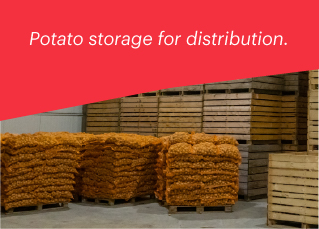Table of Contents
We can help you in the storage, transport and conservation of potatoes and all kinds of vegetables. Potatoes are a herbaceous plant belonging to the Solanaceae family. Potatoes are grown all over the world and are consumed in many different ways, such as fried, boiled, mashed or in stews. They are also used to make flour and other food products. We are talking about a vegetable that is widely known worldwide as a staple food.
Origin and varieties of potato
The origin of this tuber is in South America. It was brought to Spain in the middle of the 14th century and was initially cultivated mainly for livestock feed.
There are four main groups of potato varieties. We will highlight those that we consider the most relevant in the Spanish market, from the perspective of Antonio Marco’s customers:
- Rounded Golden: rounded or oval with thin, smooth skin and a dry taste.
- Alargadas Rojizas: oval to elongated shape, white and smooth skin.
- Elongated White: elongated shape, thin, smooth and white skin.
- Round Red: round in shape, thin-skinned, smooth and red in color.
Season and harvesting of the potato for later conservation
The season extends throughout the year, although it is more abundant in the northern hemisphere during the winter months. It is true that the use of cold storage is very important for the preservation of vegetables in periods of low demand or excess supply.
As far as potato harvesting in Spain is concerned, there are several post-harvest problems:
- Physiological:
- Mechanical damage
- Black spots
- Sprouting
- Wilt
- Skin staining
- Cold damage
- Pressure injuries
- Greening
- Pathological:
- Dry rot
- Gangrene
- Pythium
- Silver scab
- Stem and tuber rots
- Soft rot
- Ring rot
- Potato moth
We will now explain a number of key measures for cold storage of potatoes.
Potato storage for distribution
The importance of a logistic warehouse for potato conservation is key. This tuber, one of the most consumed in the world, is very important for all cold storage companies in the Levante area. With around 316,000 tons produced, Spain is the seventh largest potato exporter in the world.
Countries such as Canada, the United States and Egypt have gained weight in the European market, where they are supported by logistic warehouses where they keep the potato in cold storage in order to extend its useful life, and later, to be distributed in times when the Spanish production does not cover the demand.
Potato, a perishable food, requires a conservation temperature between 4-7°C, depending on the customer’s requirements, this may vary. A key element in the good preservation of potatoes is the loss of water after harvesting, as happens with grapefruit and other fruits and vegetables. Low temperatures and high relative humidity above 90% reduce transpiration, slow water loss, and in turn reduce the development of pathogens, helping to extend the life of the potato.
There are some important factors to consider in potato preservation:
–Temperature: condensation can damage potatoes and cause them to rot, so it is important to ensure that the temperature and humidity in the cold store remain stable and homogeneous. This can be achieved through the use of proper cooling and ventilation systems, as well as regular maintenance of the cold store to ensure proper operation.
–Ventilation: It is important to keep the potato crop dry and prevent rotting. By allowing air to circulate unimpeded, it prevents moisture build-up in storage and maintains a proper moisture level in the potatoes. In addition, ventilation also helps to regulate temperature in storage and prevent fungal growth and other quality problems in the potatoes.
–Cooling: The cooling of potatoes from field temperature to storage should be progressive. This prevents damage to the potatoes due to a sudden change in temperature and keeps them in good condition during storage. In addition, progressive cooling also helps prevent fungal growth and other quality problems in potatoes. Therefore, it is important to follow a progressive cooling process to ensure that potatoes remain fresh and in good condition during storage.
Potato transport in Spain and the rest of Europe

Potato is a commodity where the main export destinations are usually the:
- Potato transport, Spain to Italy
- Potato transport, Spain to Germany
- Transport of potato, Spain to France
- Transport of potato, Spain to Belgium
- Potato transport, Spain to Czech Republic
The ideal temperature for the transport of potatoes is between 4-7ºC continuously, although it is true that potatoes do not suffer much from temperature changes in the short term. The transport companies of Alicante and Murcia are focused on the transport of potatoes to international markets. We are companies that are in the proximity of the product, and our know-how, which we have achieved thanks to our years of experience.
We have seen that temperature-controlled storage is key, but this work will mean nothing if we do not carry out an optimal refrigerated transport of goods. Antonio Marco is clear that its logistics in Alicante is more than prepared to carry out this task, thanks to its logistics center located in Alicante. Antonio Marco is a company that can develop the activities of: transport, storage and conservation of the potato.
In Antonio Marco we can help you with the transport and conservation of potatoes with guarantee and good service.

